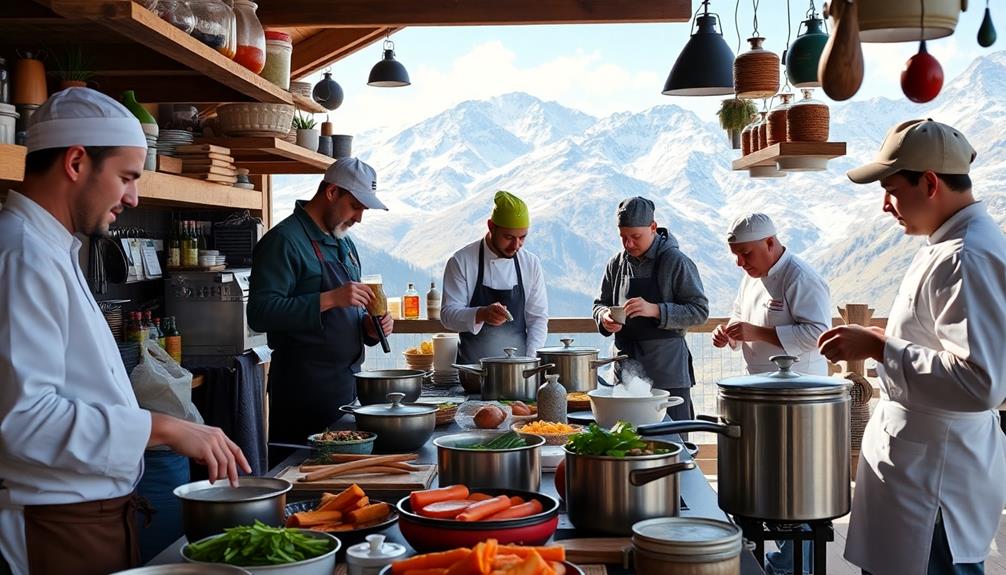Cooking at high altitudes surprises you with unexpected challenges. Water boils at lower temperatures, leading to faster moisture loss and longer cooking times for meats, pasta, and rice. If you're at 5,000 feet, you might need to add up to 25% more time to cook your meals. Baking requires precise measurements; reduce baking powder to avoid overflow. Plus, remember to cover dishes to retain moisture. Don't forget that food safety is essential, as the lower boiling point raises the risk of undercooked meals. There's much more to explore about these adjustments and techniques that can improve your high-altitude cooking experience.
Key Takeaways
- Cooking times for meats can increase by up to 25% at high altitudes, requiring careful monitoring for doneness.
- Water boils at a lower temperature at high altitudes, which affects cooking methods and times for pasta and rice.
- Baking requires precise measurements since leavening gases expand faster, necessitating adjustments like reducing baking powder.
- Frying temperatures must be decreased by 3°F for every 1,000 feet in elevation to achieve optimal cooking results.
- Food safety is crucial; lower boiling points can lead to undercooked meals, making thermometers essential for verifying internal temperatures.
High Altitude Cooking Environment

When you cook at high altitudes, typically above 2,500 feet, you'll notice significant changes in how your food behaves. The atmosphere becomes drier, leading to faster moisture evaporation from food and surfaces. This can affect cooking times and textures, making it essential to adapt your cooking methods.
For instance, dishes like Red-Braised Pork Belly that require slow braising may take longer to achieve the desired tenderness due to reduced heat transfer efficiency.
One major factor is the boiling point of water, which decreases as altitude increases. For instance, at 7,500 feet, water boils at just 198 °F, compared to 212 °F at sea level. This means you'll need longer cooking times for boiled foods, and monitoring becomes critical to avoid undercooking.
In fact, cooking times for meats may increase by up to 25% at 5,000 feet due to reduced heat transfer efficiency.
When baking, leavening gases in your ingredients expand more quickly, so precise measurements and adjustments are essential for achieving the right texture and rise.
Cooking Adjustments and Techniques

Adapting your cooking techniques at high altitudes is vital for achieving the best results. At high altitudes, the boiling point of water is lower, which means you'll need to allow for longer cooking times, especially for pasta and rice—usually an extra 2 to 5 minutes.
When cooking meats, you may find that times increase by up to 25% at elevations around 5,000 feet, while oven roasting often remains similar. For those preparing hearty dishes like Slow-Cooked Pork Belly, it's important to monitor cooking times closely to achieve that melt-in-your-mouth consistency.
For baking, make important altitude adjustments by reducing your baking powder by 1/8 teaspoon per teaspoon and cutting sugar by 1 tablespoon per cup in cake recipes at elevations between 3,500 to 6,500 feet.
When frying, remember to decrease the frying temperature by 3°F for every 1,000 feet of elevation to guarantee ideal results. Moisture retention is particularly important in the drier atmosphere found at high altitudes, so consider covering your food while cooking to keep heat and moisture locked in.
Specific Cooking Methods Adjustments

Cooking at high altitudes requires specific adjustments across various methods to guarantee your dishes turn out perfectly.
In high altitude cooking, the lower boiling point of water means foods like pasta and rice take an additional 2 to 5 minutes to cook. This is similar to how Brazilian cuisine often involves unique cooking techniques that enhance flavor and texture. Keep a close eye on them to make sure they're done right.
When baking at high elevations, it's essential to reduce your baking powder by 1/8 teaspoon for each teaspoon to avoid overflow and enhance texture.
For deep-frying, adjust the cooking temperature by lowering the fat temperature by 3°F for every 1,000 feet of elevation. This compensation helps maintain proper frying results.
If you're using slow cookers, begin on high for the first hour to guarantee adequate heating, then switch to low without lifting the lid, which helps retain steam and heat.
Steaming is a fantastic method at high altitudes, as it maximizes moisture retention in meats, preventing excessive drying and cooking loss that often occurs with boiling or roasting.
Always remember to take into account these adjustments for successful cooking at elevation!
Importance of Food Safety Practices

Food safety practices are indispensable at high altitudes, where the unique cooking conditions can compromise both the quality and safety of your meals. At these elevations, water boils at a lower temperature, affecting cooking times and increasing evaporation rates, which can lead to undercooked meals. To guarantee food safety, using food thermometers is imperative. They help you verify that meats and poultry reach the safe internal temperature, preventing foodborne illnesses.
Here's a quick reference table for food safety practices at high altitudes:
| Food Type | Safe Temperature (°F) | Time Limits at Room Temperature |
|---|---|---|
| Hot Food | 140°F or above | 2 hours |
| Cold Food | Below 40°F | 2 hours (1 hour if >90°F) |
| Canned Low-Acid | Varies by elevation | N/A |
| Cooked Meats | 165°F | 2 hours |
Maintaining proper temperatures is essential. For hot foods, keep them at 140°F or higher, and for cold foods, nest them in ice. Always monitor cooking times carefully to avoid spoilage and guarantee delicious results.
Community Insights and Resources

Steering through the challenges of high-altitude cooking is a shared experience among community members who often come together to exchange valuable insights and resources. Steering through the challenges of high-altitude cooking is a shared experience among community members who often come together to exchange valuable insights and resources. These gatherings foster not only practical advice but also discussions about how climate change and global cuisines are influencing traditional cooking methods. By sharing recipes and adapting techniques, the community embraces a fusion of flavors while addressing the evolving environmental factors that impact their culinary practices.
You'll find that many have amusing stories about adapting recipes when moving from sea level to high altitude. For instance, just like the adjustments made in dishes such as Mushroom Masala, humor helps lighten the challenges of cooking and baking in lower atmospheric pressure, where adjustments are essential.
Community members recommend specific modifications, like reducing sugar and baking powder, to combat the effects of increased evaporation.
They also emphasize the importance of closely monitoring cooking temperatures, especially when making candy or baked goods. Using food thermometers becomes vital for ensuring safety and achieving proper doneness.
Don't shy away from experimenting with high-altitude variations in commercial recipe mixes. These often come with tailored instructions that cater to your specific elevation, increasing your chances of success.
For deeper insights, many reference resources like "The Food Lab" by Kenji Lopez-Alt, which provides both practical guidance and a humorous take on steering through high-altitude cooking.
Embrace these community insights and resources, and you'll find yourself thriving in your high-altitude kitchen.
Frequently Asked Questions
How Does Altitude Affect Cooking?
Altitude affects cooking by lowering water's boiling point, which alters cooking times and methods. You'll need to adjust ingredients and techniques to guarantee your dishes turn out well, especially when boiling or baking.
What Are the Adjustments for Cooking at Altitude?
When cooking at altitude, you'll need to adjust cooking times, reduce baking powder, lower frying temperatures, increase liquids, and possibly decrease sugar. These tweaks help guarantee your dishes turn out perfectly despite the elevation challenges.
What Gas Law Affects Cooking at High Altitudes?
The Ideal Gas Law affects cooking at high altitudes. It explains how decreased pressure lowers boiling points, causing water to evaporate faster. You'll need to adjust cooking times and temperatures for successful results.
Does High Altitude Affect the Taste of Food?
Imagine tasting a beautiful melody turned flat; that's what high altitude can do to food. You'll find flavors dulled, but adding spices and flavorful ingredients can help your dishes sing once more.
Conclusion
In high-altitude cooking, you might be surprised to learn that water boils at about 202°F instead of the usual 212°F, which can drastically alter your recipes. This means adjustments are essential for successful results. By understanding these unique challenges and applying the right techniques, you can elevate your culinary skills. Remember, even small changes can lead to big improvements, so embrace the altitude and get creative in the kitchen!










